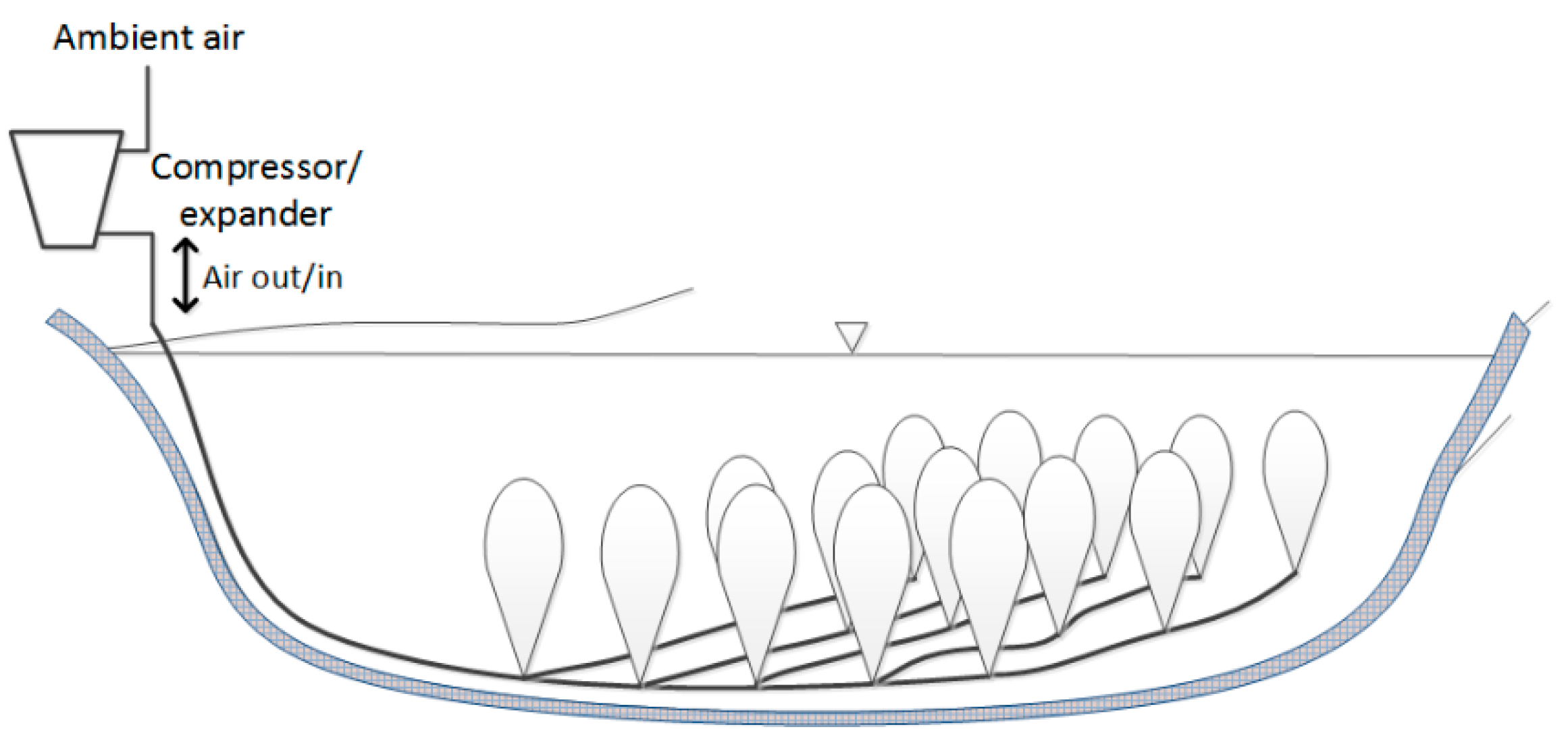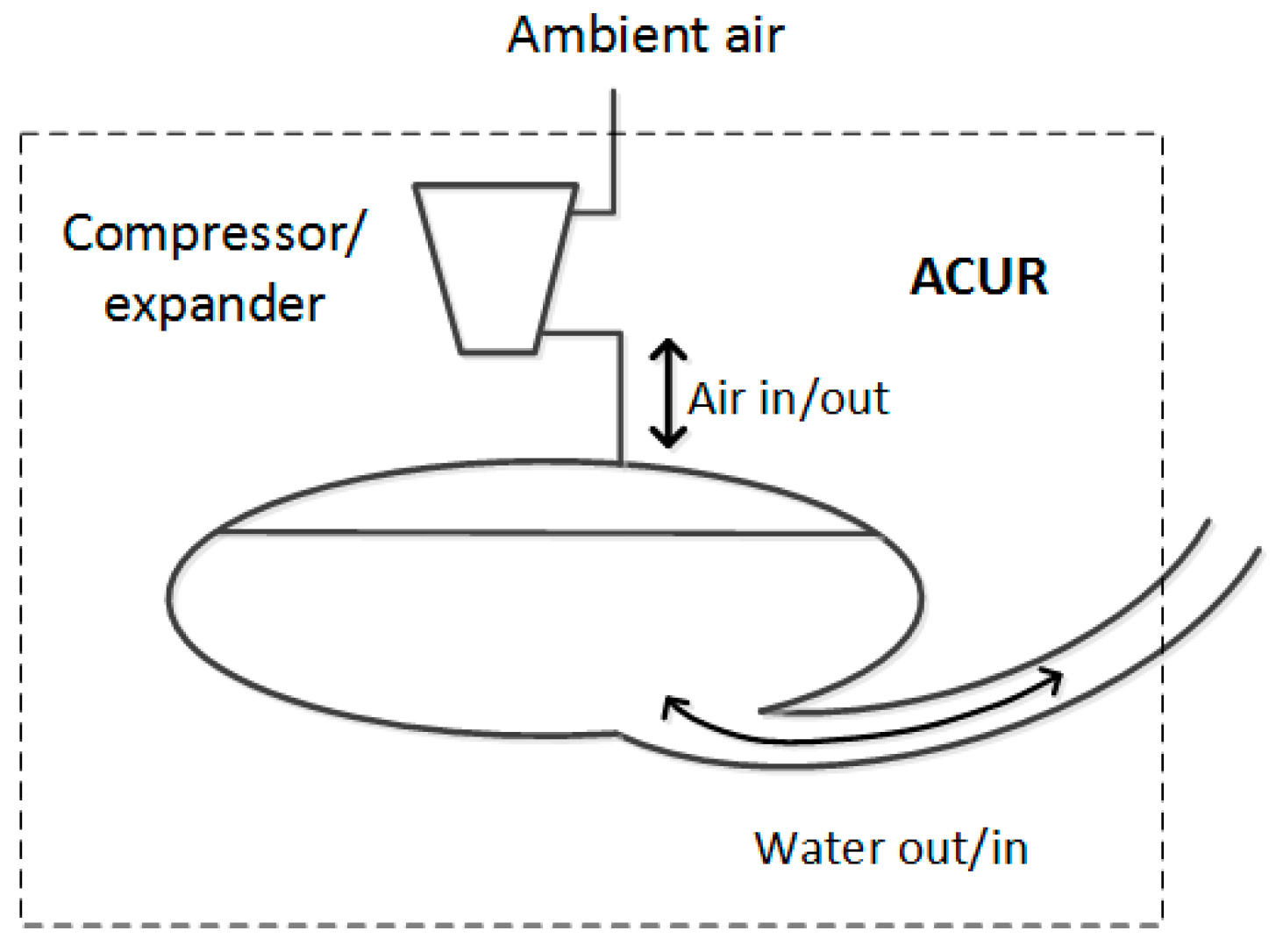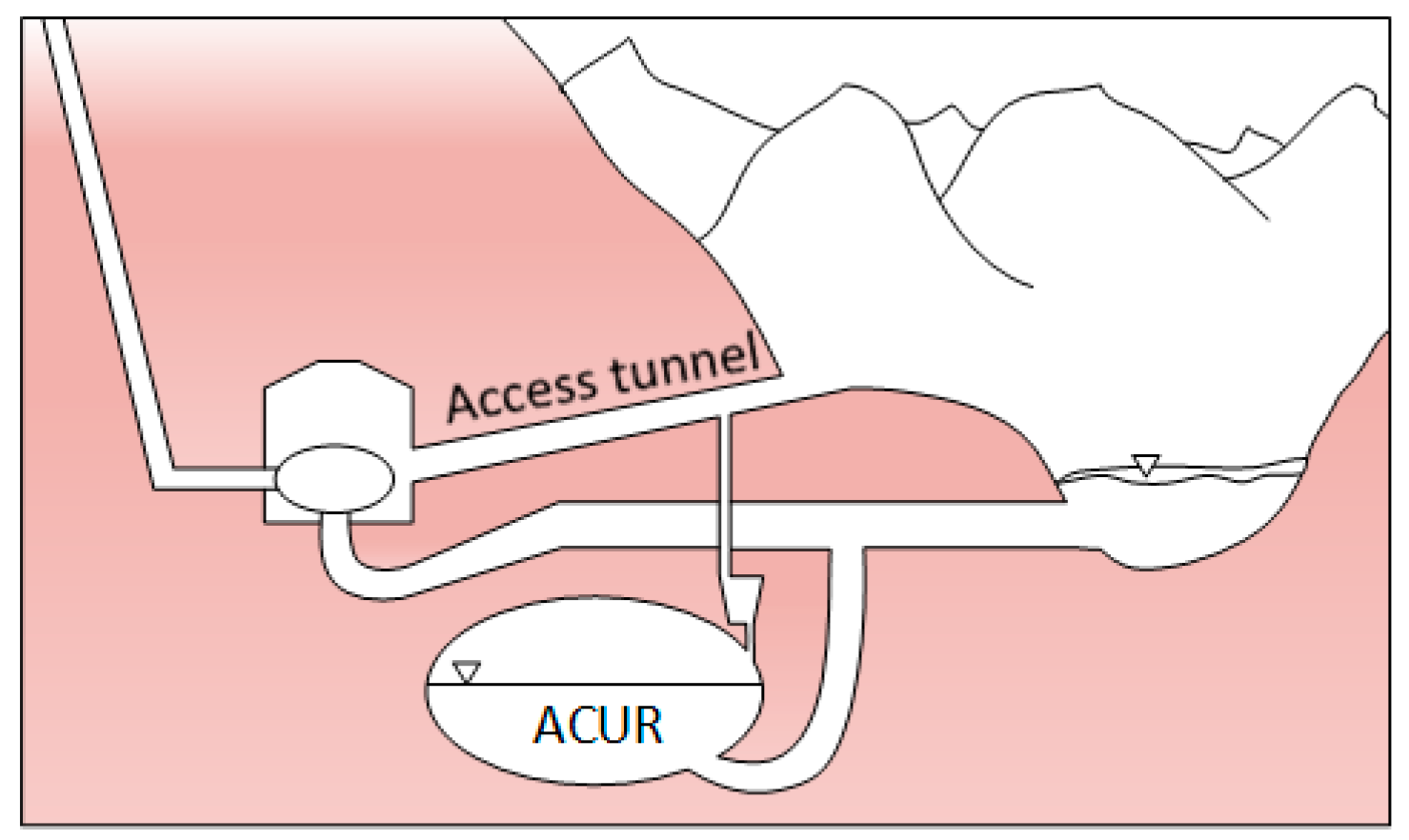A New Technical Concept for Water Management and Possible Uses in Future Water Systems
Abstract
:1. Introduction
2. New Technical Concepts; Method
2.1. Displacing Water Using Compressed Air
Energy Considerations
2.2. Examples of Use of the New Capabilities
2.2.1. Inflatable Balloons
2.2.2. Air Cushion Underground Cavern (ACUR)
3. Applications
3.1. Floods, Droughts and Discharge Fluctuation Manipulations
3.2. Energy Storage and Power Production
3.3. Environmental Operation
4. Discussion
5. Conclusions
Author Contributions
Funding
Conflicts of Interest
Appendix A

References
- Kumar, A.; Schei, T.; Ahenkorah, A.; Rodriguez, R.C.; Devernay, J.-M.; Freitas, M.; Hall, D.; Killingtveit, Å.; Liu, Z.; Heath, G. Hydropower. In IPCC Special Report on Renewable Energy Sources and Climate Change Mitigation; Edenhofer, O., Pichs-Madruga, R., Sokona, Y., Seyboth, K., Matschoss, P., Kadner, S., Zwickel, T., Eickemeier, P., Hansen, G., Schlömer, S., et al., Eds.; Cambridge University Press: Cambridge, UK; New York, NY, USA, 2011; Available online: https://www.ipcc.ch/site/assets/uploads/2018/03/Chapter-5-Hydropower-1.pdf (accessed on 25 October 2019).
- Nakićenović, N.; Alcamo, J.; Davis, G.; de Vries, B.; Fenhann, J.; Gaffin, S.; Gregory, K.; Griibler, A.; Jung, T.; Kram, T.; et al. Special Report on Emissions Scenarios: A Special Report of Working Group III of the Intergovernmental Panel on Climate Change; Nakićenović, N., Swart, R., Eds.; Cambridge University Press: Cambridge, UK; New York, NY, USA, 2000; ISBN 978-0-521-80081-5. Available online: https://www.ipcc.ch/site/assets/uploads/2018/03/emissions_scenarios-1.pdf (accessed on 25 October 2019).
- Trenberth, K. Changes in precipitation with climate change. Clim. Res. 2011, 47, 123–138. [Google Scholar] [CrossRef]
- European Commision. The Effects of Temporary State Aid Rules Adopted in the Context of the Financial and Economic Crisis. 2011. Available online: https://ec.europa.eu/competition/publications/reports/temporary_stateaid_rules_en.html (accessed on 25 October 2019).
- International Energy Agency (IEA). World Energy Investment 2018. Available online: https://www.iea.org/wei2018/ (accessed on 25 October 2019).
- Cengel, Y.A.; Cimbala, J.M. Fluid Mechanics, Fundamentals and Applications, 3rd ed.; McGraw Hill Education: New York, NY, USA, 2014; ISBN 987-1-259-01122-1. [Google Scholar]
- Juárez, A.; Adeva-Bustos, A.; Alfredsen, K.; Dønnum, B.O. Performance of A Two-Dimensional Hydraulic Model for the Evaluation of Stranding Areas and Characterization of Rapid Fluctuations in Hydropeaking Rivers. Water 2019, 11, 201. [Google Scholar] [CrossRef]
- Bin Asad, S.M.S.; Lundström, T.S.; Andersson, A.G.; Hellström, J.G.I.; Leonardsson, K. Wall Shear Stress Measurement on Curve Objects with PIV in Connection to Benthic Fauna in Regulated Rivers. Water 2019, 11, 650. [Google Scholar] [CrossRef]
- De Jong, M. Commercial Grid Scaling of Energy Bags for Underwater Compressed Air Energy Storage. In Proceedings of the 2014 Offshore Energy & Storage Symposium, Windsor, ON, Canada, 10–11 July 2014; Available online: http://www.thin-red-line.com/140714_ThinRedLine_OSES2014.pdf (accessed on 25 October 2019).
- Salvadore, E.; Bronders, J.; Batelaan, O. Hydrological modelling of urbanized catchments: A review and future directions. J. Hydrol. 2015, 529, 62–81. [Google Scholar] [CrossRef]
- Moen, T.S. Mitigation of Discharge Fluctuations from Hydropower Plants by Active Measures. Master’s Thesis, Norwegian University of Science and Technology, Trondheim, Norway, June 2018. [Google Scholar]
- Heggenes, J.; Traaen, T. Downstream migration and critical water velocities in stream channels for fry of four salmonid species. J. Fish Biol. 1988, 32, 717–727. [Google Scholar] [CrossRef]
- Lindmark, E.; Gustavsson, L.H. Field study of an attraction channel as entrance to fishways. River Res. Appl. 2008, 24, 564–570. [Google Scholar] [CrossRef]
- Green, T.M.; Lindmark, E.M.; Lundström, T.S.; Gustavsson, L.H. Flow characterization of an attraction channel as entrance to fishways. River Res. Appl. 2011, 27, 1290–1297. [Google Scholar] [CrossRef]
- McDonald, R.R.; Nelson, J.M.; Paragamian, V.; Barton, G.J. Modeling hydraulic and sediment transport processes in white sturgeon spawning habitat on the Kootenai River, Idaho. J. Hydraul. Eng. 2017, 136, 1077–1092. [Google Scholar] [CrossRef]
- ACI Conference EU EES2 Site Visit. Available online: https://web.archive.org/web/20130206134815/http://www.wplgroup.com/aci/conferences/eu-ees2-site-visit.asp (accessed on 25 October 2019).
- Storli, P.-T. Novel methods of increasing the storage volume at Pumped Storage Power plants. Int. J. Fluid Mach. Syst. 2017, 10, 209–217. [Google Scholar] [CrossRef]
- Glover, B.; Sølthun, N.R.; Walløe, K.L. Verdien av Vassdragsreguleringer for Reduksjon av Flomskader; Multiconsult: Oslo, Norway, 2018; Available online: https://www.energinorge.no/contentassets/368e1425713a4c3a8a47fce6dd86dffe/flomrapport-22-03-2018.pdf (accessed on 25 October 2019).
- Viseth, E.S. 70 Prosent av Norske Vannkraftverk Skal få Nye Kjøreregler—Statkraft Frykter Flomvernet Blir for Dårlig. Available online: https://www.tu.no/artikler/70-prosent-av-norske-vannkraftverk-skal-fa-nye-kjoreregler-statkraft-frykter-flomvernet-blir-for-darlig/449373 (accessed on 25 October 2019).
- Charmasson, J.; Zinke, P. Mitigation Measures against Hydropeaking Effects; SINTEF: Trondheim, Norway, 2011; ISBN 978-82-594-3517-0. [Google Scholar]
- Moog, O. Quantification of daily peak hydropower effects on aquatic fauna and management to minimize environmental impacts. Regul. Rivers Res. Manag. 1993, 8, 5–14. [Google Scholar] [CrossRef]
- Schleiss, A.J.; Speerli, J.; Pfammatter, R. Swiss Competences in River Engineering and Restoration; CRC Press: Boca Raton, FL, USA, 2014; ISBN 978-1-4987-0443-4. [Google Scholar]
- Mestvedthagen, M. Increasing Operational Flexibility of Hydropower by New Technology. Master’s Thesis, Norwegian University of Science and Technology, Trondheim, Norway, June 2019. [Google Scholar]
- Medina, D.C.; Findley, S.E.; Doumbia, S. State–Space Forecasting of Schistosoma haematobium Time-Series in Niono, Mali. PLoS Negl. Trop. Dis. 2008, 2, e276. [Google Scholar] [CrossRef]
- Yirefu, F.; Tafesse, A.; Gebeyehu, T.; Tessema, T. Distribution, Impact and Management of Water Hyacinth at Wonji-Shewa Sugar Factory. Eth. J. Weed Mgt. 2007, 1, 41–52. [Google Scholar]
- Zhou, Y.; Hejazi, M.; Smith, S.; Edmonds, J.; Li, H.; Clarke, L.; Calvin, K.; Thomson, A. A comprehensive view of global potential for hydro-generated electricity. Energy Environ. Sci. 2015, 8, 2622–2633. [Google Scholar] [CrossRef]










© 2019 by the authors. Licensee MDPI, Basel, Switzerland. This article is an open access article distributed under the terms and conditions of the Creative Commons Attribution (CC BY) license (http://creativecommons.org/licenses/by/4.0/).
Share and Cite
Storli, P.-T.; Lundström, T.S. A New Technical Concept for Water Management and Possible Uses in Future Water Systems. Water 2019, 11, 2528. https://doi.org/10.3390/w11122528
Storli P-T, Lundström TS. A New Technical Concept for Water Management and Possible Uses in Future Water Systems. Water. 2019; 11(12):2528. https://doi.org/10.3390/w11122528
Chicago/Turabian StyleStorli, Pål-Tore, and T. Staffan Lundström. 2019. "A New Technical Concept for Water Management and Possible Uses in Future Water Systems" Water 11, no. 12: 2528. https://doi.org/10.3390/w11122528
APA StyleStorli, P.-T., & Lundström, T. S. (2019). A New Technical Concept for Water Management and Possible Uses in Future Water Systems. Water, 11(12), 2528. https://doi.org/10.3390/w11122528





